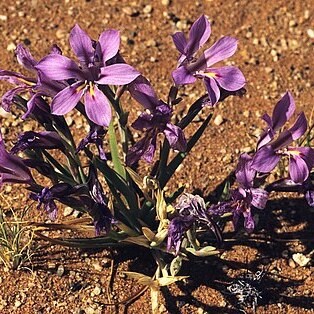Plants 70-150 mm high, usually branched, sometimes repeatedly, mainly from base; stem compressed and 2-angled to 2-winged, wings often lightly serrated, with cormlet at each of 2 underground nodes. Corm bell-shaped, usually 60-90 mm below ground, ± 8 mm diam., tunics brown, fairly smooth, basal rim lightly serrated, teeth directed downward. Leaves 4 to 6 (or more), lowermost 1 or 2 longest and slightly to about twice as long as stem, linear, ascending to ± falcate, 1.5-2.0 mm wide, corrugately ribbed, upper leaves shorter than stem. Inflorescences 2-to 5-flowered spikes; outer bracts green, veins translucent, lanceolate and acute or acuminate, (10-)20-25 mm long, folded and angular along upper midline, often keeled near apex, margins broadly hyaline; inner bracts ± 1/2 as long as outer, transparent with 2 green keels, forked and turning brown at apex. Flowers zygomorphic, light purple-pink to lilac, lower tepals with basal ridge or claw-like tooth near base, marked with median yellow streak edged distally in dark red to purple, odourless; perianth tube obliquely funnel-shaped, (15-)20-25 mm long (often shorter in dry years, or apparently shorter in herbarium material), narrowly cylindric below, abruptly expanded in upper 4-5 mm into wide cylindric throat; tepals subequal, lanceolate, acute, upper 3 slightly larger, 24-27 x ± 6-7 mm, lower 3 united for 2-3 mm and thus slightly shorter, 18-22 x 5-6 mm, all weakly differentiated below into claws ± 8 mm long, claws forming wide cup, limbs spreading at right angles to claws, when fully open held ± in one plane. Stamens unilateral, arcuate; filaments ± 10 mm long, exserted ± 5 mm from tube but included in cup formed by tepal claws; anthers 5-6 mm long, included in floral cup, shortly apiculate, usually ± white; pollen white. Style arching over stamens, dividing close to or 1-2 mm beyond anther tips; branches ± 5 mm long, divided for 2/3 their length, spreading beyond anthers. Capsules oblong to ovoid, 8-10 mm long. Seeds 1.2-1.3 mm diam., round, smooth.
More
Cormous geophyte, 100-150 mm tall, corm tunics dark brown, margins with short, down-pointed teeth. Leaves sword-shaped, ribbed. Flowers in few-flowered, dense spikes, deep lilac to purple, perianth tube funnel-shaped, tepals clawed below and cupped, bracts short, narrow.

